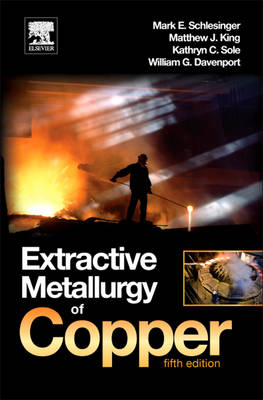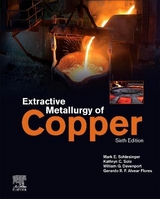
Extractive Metallurgy of Copper
Elsevier / The Lancet (Verlag)
978-0-08-096789-9 (ISBN)
- Titel erscheint in neuer Auflage
- Artikel merken
This multi-author new edition revises and updates the classic reference by William G. Davenport et al (winner of, among other awards, the 2003 AIME Mineral Industry Educator of the Year Award "for inspiring students in the pursuit of clarity"), providing fully updated coverage of the copper production process, encompassing topics as diverse as environmental technology for wind and solar energy transmission, treatment of waste by-products, and recycling of electronic scrap for potential alternative technology implementation. The authors examine industrially grounded treatments of process fundamentals and the beneficiation of raw materials, smelting and converting, hydrometallurgical processes, and refining technology for a mine-to-market perspective - from primary and secondary raw materials extraction to shipping of rod or billet to customers. The modern coverage of the work includes bath smelting processes such as Ausmelt and Isasmelt, which have become state-of-the-art in sulfide concentrate smelting and converting.
Mark E. Schlesinger is a graduate of the University of Missouri–Rolla and the University of Arizona. He has spent a combined 31 years of teaching at The University of Utah and the Missouri University of Science and Technology. He is an author of: • Mass and Energy Balances in Materials Engineering • Extractive Metallurgy of Copper (4th and 5th English–language editions; Chinese edition) • Aluminum Recycling (two English language editions)Professor Schlesinger is a member of the (U.S.) Metals, Minerals, and Materials Society; the American Institute for Steel Technology; and the Society of Mining, Metallurgy and Exploration. He is a former Fulbright Scholar (Royal Institute of Technology (Sweden), 2002), and Leif Eriksson Fellow (Norwegian University of Science and Technology, 2012–13). He was named a Fellow of ASM International (2018). Kathryn C. Sole has 30 years’ global experience in the chemistry and process engineering of hydrometallurgical extractive processes, with specialist expertise in solvent extraction, ion exchange, and electrowinning. She is currently an independent consultant, with clients spanning six continents. Kathy has worked with copper production operations in Africa, USA, and South America, including those of Anglo American, Eurasian Resource Group, Glencore, Vedanta, First Quantum, and BHP. Kathy holds an adjunct appointment at the University of Pretoria and regularly presents accredited Continuing Professional Development training courses, many of which focus on hydrometallurgy of copper. She has authored/coauthored over 90 publications, including Extractive Metallurgy of Copper (5th ed.), and is a member of the Editorial Boards of the journals Minerals Processing & Extractive Metallurgy Review and Solvent Extraction & Ion Exchange. She founded and chairs the Copper Cobalt Africa conference series. Kathy obtained her PhD in metallurgical engineering from the University of Arizona, USA, following BSc(Hons) and MSc degrees in chemistry from Rhodes University, South Africa. She has been awarded the Silver Medal of the Southern African Institute of Mining and Metallurgy, the Bronze Medal of the South African Association for the Advancement of Science, and received the Milton E. Wadsworth Award of the Society of Mining, Metallurgy and Exploration in 2019. Professor William George Davenport is a graduate of the University of British Columbia and the Royal School of Mines, London. Prior to his academic career he worked with the Linde Division of Union Carbide in Tonawanda, New York. He spent a combined 43 years of teaching at McGill University and the University of Arizona. His Union Carbide days are recounted in the book Iron Blast Furnace, Analysis, Control and Optimization (English, Chinese, Japanese, Russian and Spanish editions). During the early years of his academic career he spent his summers working in many of Noranda Mines Company’s metallurgical plants, which led quickly to the book Extractive Metallurgy of Copper. This book has gone into five English language editions (with several printings) and Chinese, Farsi and Spanish language editions. He also had the good fortune to work in Phelps Dodge’s Playas flash smelter soon after coming to the University of Arizona. This experience contributed to the book Flash Smelting, with two English language editions and a Russian language edition and eventually to the book Sulfuric Acid Manufacture (2006), 2nd edition 2013. In 2013 co-authored Extractive Metallurgy of Nickel, Cobalt and Platinum Group Metals, which took him to all the continents except Antarctica. He and four co-authors are just finishing up the book Rare Earths: Science, Technology, Production and Use, which has taken him around the United States, Canada and France, visiting rare earth mines, smelters, manufacturing plants, laboratories and recycling facilities. Professor Davenport’s teaching has centered on ferrous and non-ferrous extractive metallurgy. He has visited (and continues to visit) about 10 metallurgical plants per year around the world to determine the relationships between theory and industrial practice. He has also taught plant design and economics throughout his career and has found this aspect of his work particularly rewarding. The delight of his life at the university has, however, always been academic advising of students on a one-on-one basis. Professor Davenport is a Fellow (and life member) of the Canadian Institute of Mining, Metallurgy and Petroleum and a twenty-five year member of the (U.S.) Society of Mining, Metallurgy and Exploration. He is recipient of the CIM Alcan Award, the TMS Extractive Metallurgy Lecture Award, the AusIMM Sir George Fisher Award, the AIME Mineral Industry Education Award, the American Mining Hall of Fame Medal of Merit and the SME Milton E. Wadsworth award. In September 2014 he will be honored by the Conference of Metallurgists’ Bill Davenport Honorary Symposium in Vancouver, British Columbia (his home town).
1. Overview 2. Production and Use 3. Production of High Copper Concentrates – Introduction and Comminution 4. Production of Cu Concentrate from Finely Ground Cu Ore 5. Matte Smelting Fundamentals 6. Flash Smelting 7. Submerged Tuyere Smelting 8. Converting of Copper Matte 9. Bath Matte Smelting 10. Direct-To-Copper Flash Smelting 11. Copper Loss in Slag 12. Capture and Fixation of Sulfur 13. Fire Refining (S and O Removal) and Anode Casting 14. Electrolytic Refining 15. Hydrometallurgical Copper Extraction 16. Solvent Extraction 17. Electrowinning 18. Collection and Processing of Recycled Copper 20. Melting and Casting 21. Byproduct and Waste Streams 22. Costs of Copper Production
| Verlagsort | London |
|---|---|
| Sprache | englisch |
| Maße | 152 x 229 mm |
| Gewicht | 1100 g |
| Themenwelt | Technik ► Maschinenbau |
| ISBN-10 | 0-08-096789-2 / 0080967892 |
| ISBN-13 | 978-0-08-096789-9 / 9780080967899 |
| Zustand | Neuware |
| Informationen gemäß Produktsicherheitsverordnung (GPSR) | |
| Haben Sie eine Frage zum Produkt? |
aus dem Bereich



